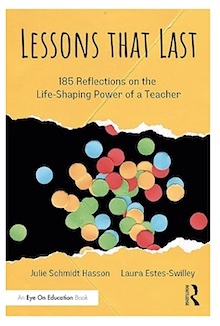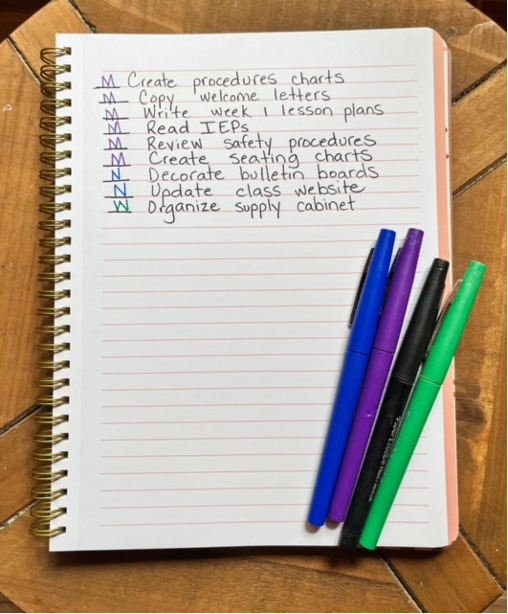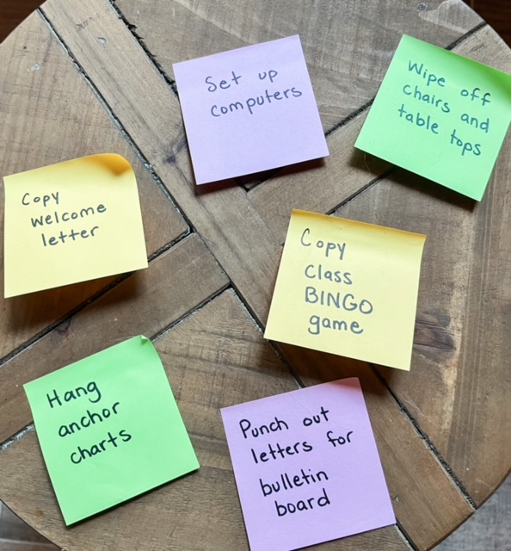3 Ways to Relieve Back to School ‘Overwhelm’
By Julie Schmidt Hasson
 I have the same dream every August. I’m standing in a river with a thousand floating rubber ducks, trying to gather them and put them in a basket. The current keeps getting stronger and the ducks drift farther and farther away.
I have the same dream every August. I’m standing in a river with a thousand floating rubber ducks, trying to gather them and put them in a basket. The current keeps getting stronger and the ducks drift farther and farther away.
This dream means that a new school year is about to begin, and I do not have my ducks in a row. I’ve been an educator for over 30 years, but the start of the year still feels a bit overwhelming. Teaching can be stressful, and the stress level spikes at certain times of the year.
Unlike typical teacher stress, overwhelm is an intense level of stress and emotional overload. When overwhelmed, you may feel unable to cope with or manage demands. You may feel swamped, out of control, or unable to think clearly. When these feelings emerge, it’s essential to take a pause, take a step back, and gain some perspective.
It helps to remind yourself that these feelings are normal. Recognize and accept your feelings and the situation you are in. When you know you’re headed for a time likely to bring a sense of overwhelm, you can plan accordingly, enlist some help and support from family and friends, and adopt some useful practices.
Reducing back-to-school overwhelm involves strategies to help manage workload, enhance organization, and promote well-being. Luckily, I’ve found a few tricks and tools over the years to lessen the risk of becoming overwhelmed.
Manage Your Tasks
According to Dr. Amit Sood, the average person has over 150 unfinished tasks at any given time. That number is likely much higher for teachers at the beginning of a school year. All those open mental tabs take a toll as our minds bounce from one to another.
In default mode, our minds are wandering between those open tabs and also wandering into worries, regrets, and random thoughts. Our brains have a limited capacity for processing information, and having many undone tasks can lead to cognitive overload, making it difficult to focus and think clearly.
The first step in decreasing overload is getting all those tasks out of our heads and onto paper (or a device). I’m old school, and I love a spiral journal. I call it my thought catcher, and I use it to capture anything swimming around in my head. You could also do this with your phone, tablet, or laptop.
Start by listing every task in your mental to-do list, even the seemingly small ones. Once you’ve captured them, categorize each one. Put a letter M next to the Must Do’s. These are the tasks that must be done to facilitate a peaceful and productive first week of school. These may include creating procedure charts, writing lesson plans, and noting student accommodations.
Next, put a letter N next to the Nice to Do’s. These tasks would be helpful, but they aren’t crucial or absolutely necessary. These may include decorating the bulletin board or updating the class website. Finally, put a letter W next to the tasks that can wait. Sure, you would love to get them done, but they could be done later. These may include adding new books to the class library or cleaning out a cabinet.
Without clear priorities, it’s challenging to know where to start, which can create a sense of chaos and increase stress levels. It’s tempting to think everything is a Must Do, but be realistic and discerning as you prioritize.
Try to look at the list from a student perspective. Your students just want to know that they will be safe and enjoy learning with a competent and caring teacher. As a researcher, I’ve talked to hundreds of people about their most impactful teachers and none of them mentioned room décor or bulletin boards. Do not let social media or perfectionist peers influence your decisions as you prioritize your list.
Sort, Time and Plan
Once you have each task on your list labeled with M, N, or W, it’s time to rewrite the list. Group all tasks designated as Must Do’s at the top of the list. Group the Nice to Do’s underneath. Put all the Can Wait’s on a separate list. Next, estimate the time each of your tasks labeled M or N will take.
I’ve learned that everything takes longer than I think; so be generous in your estimation. You can also break the big tasks into smaller tasks. This makes it easier to schedule and can reduce inner resistance and the tendency toward temporizing, which often accompany big tasks.
Now you can start to plan your days. Constantly deciding which task to tackle next can lead to decision fatigue, reducing the quality of decisions and leading to procrastination. I get distracted and drift without a schedule, and so I schedule work days like a school day. I use my list and estimated times to put my prioritized tasks on my schedule.
I include some breaks because I am much less productive when fatigued. I also put all the shorter, smaller tasks on sticky notes and stick them to a table top or wall. Then, when I have 10-15 minutes between meetings, I can grab a small task and get it done. Also, when a former student, parent volunteer, or chatty colleague stops by, they can grab a task to do while visiting. It feels great to cross things off the list, and doing so helps us move from overwhelmed to empowered.
Mind Your Thoughts
How you think about your overflowing plate impacts how you navigate this challenging time of year. I’ll admit, I can quickly catastrophize a challenging situation. When I feel overwhelmed, I will start to think about all I need to accomplish, and I’ll latch onto the unhelpful belief that I’ll never get it all done. My mind will take me from undone lesson plans to losing my job to living in a van down by the river. (I blame Matt Foley, the Saturday Night Live character embodied by Chris Farley in the 1990s).
Being stuck in a negative spiral is not strong footing for tackling challenges. I’ve learned it’s much more helpful to view the situation with realistic optimism, which means acknowledging the reality while still believing that things can get better.
Practicing realistic optimism requires taking an accurate assessment of reality and considering probable outcomes, but not giving unwanted outcomes any extra attention. It means seeing obstacles but also finding workarounds. Realistic optimists are productive problem solvers. We don’t ignore the problems, but we also don’t get stuck under the weight of the challenge. Realistic optimists understand that the path through a challenge entails action. Because we know we can succeed, we keep trying.
When you experience unhelpful thoughts of overwhelm, write them down. Ask yourself if they are true and if they are helpful. I already live by a river, and I don’t even own a van; so I’m disregarding that thought. You, too, can choose to focus on true and helpful thoughts. It can help to visualize the catastrophic thoughts in a big balloon floating away. Then move on to productive problem solving. Make a realistic plan and work the plan with an optimistic attitude.
Stay Flexible
When it comes to the beginning of a school year, expect the unexpected. Schedules will change, class lists will change, technology will have glitches, and the copier will jam. Being mentally prepared for surprises helps you adapt quickly when they occur.
It’s wonderful to visualize your perfect start, but reality will never match the picture in your head. Have positive expectations but stay flexible. Give yourself grace as you prepare; focus on progress over perfection. Each time you check something off your list, celebrate that win.
Remember, your students are not hoping for a perfect teacher, perfect classroom, or perfect lessons. They are hoping to be accepted and engaged in a welcoming learning space with a welcoming teacher. Being frazzled or frustrated isn’t good for them or for you. Enjoy getting to know them and embrace the beauty of a fresh start. After all, something unexpected may turn out to be unexpectedly good.

Her latest book is Lessons that Last: 185 Reflections on the Life-Shaping Power of a Teacher (Routledge/Eye On Education, 2024), co-authored with teacher Laura Estes-Swilley. Safe, Seen, and Stretched in the Classroom: The Remarkable Ways Teachers Shape Students’ Lives, was published in 2022. Pause, Ponder, and Persist in the Classroom: How Teachers Turn Challenges into Opportunities for Impact, was released in 2023. Visit Julie’s website.
Feature image by Manfred Richter from Pixabay































